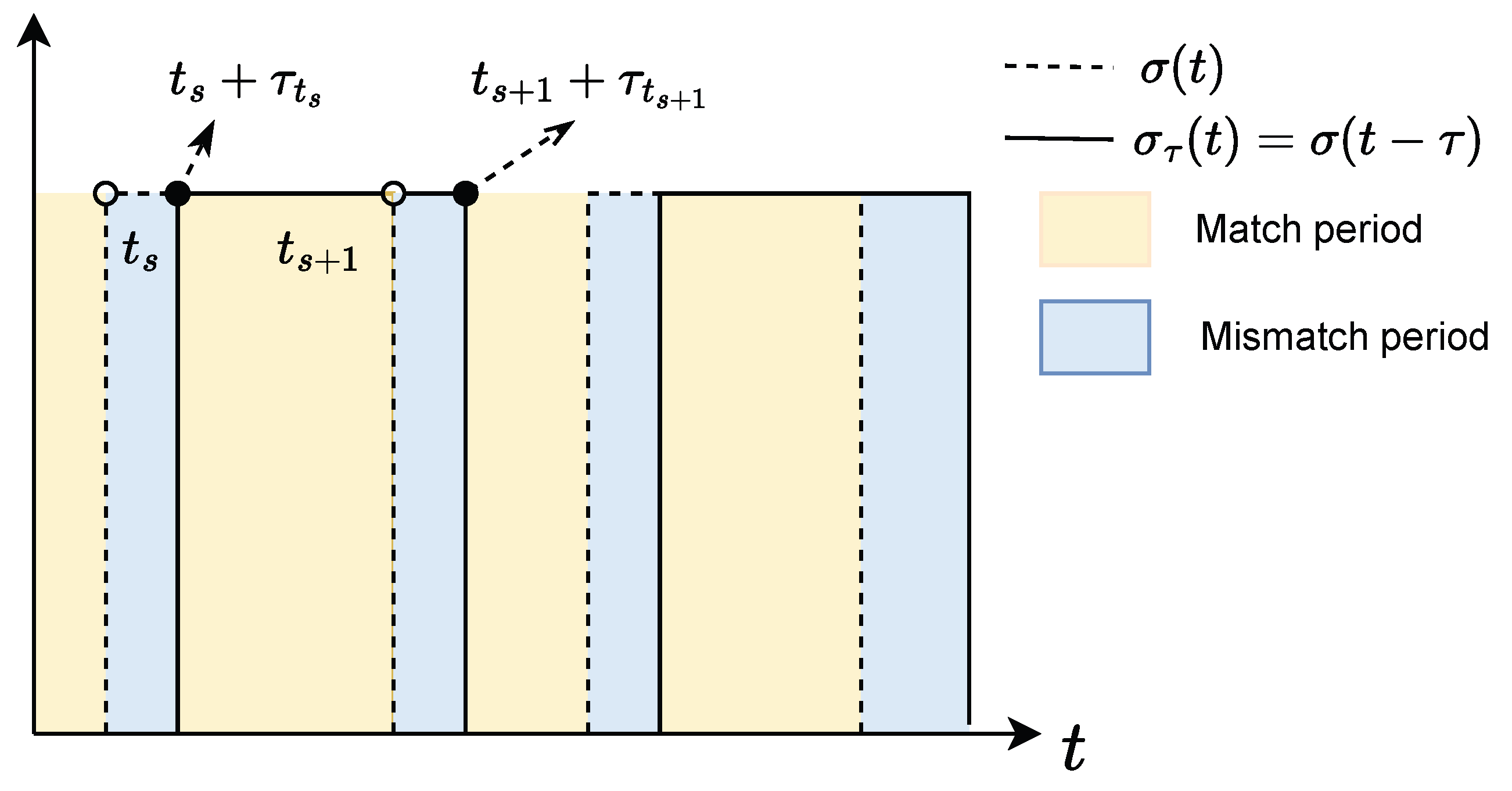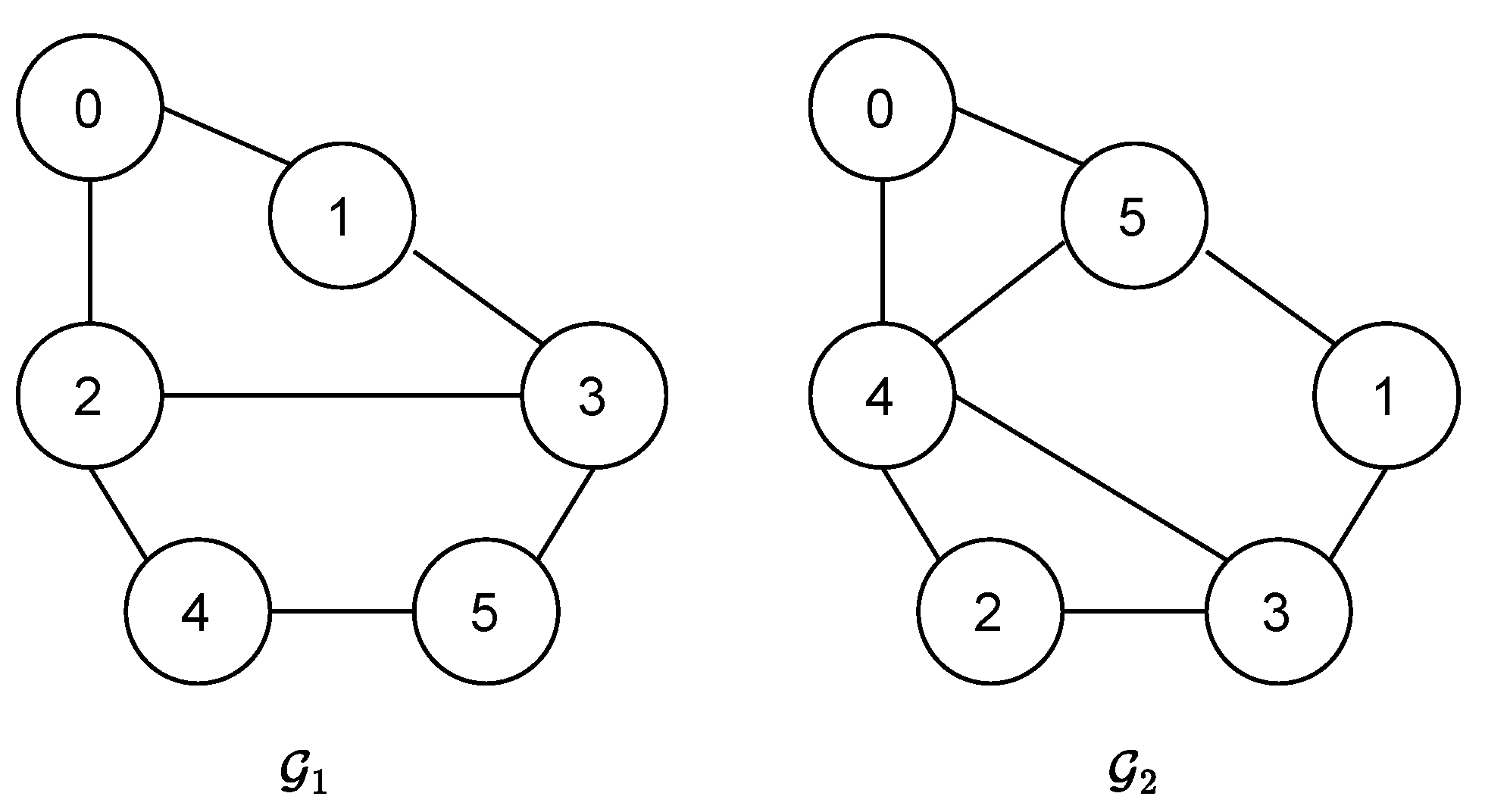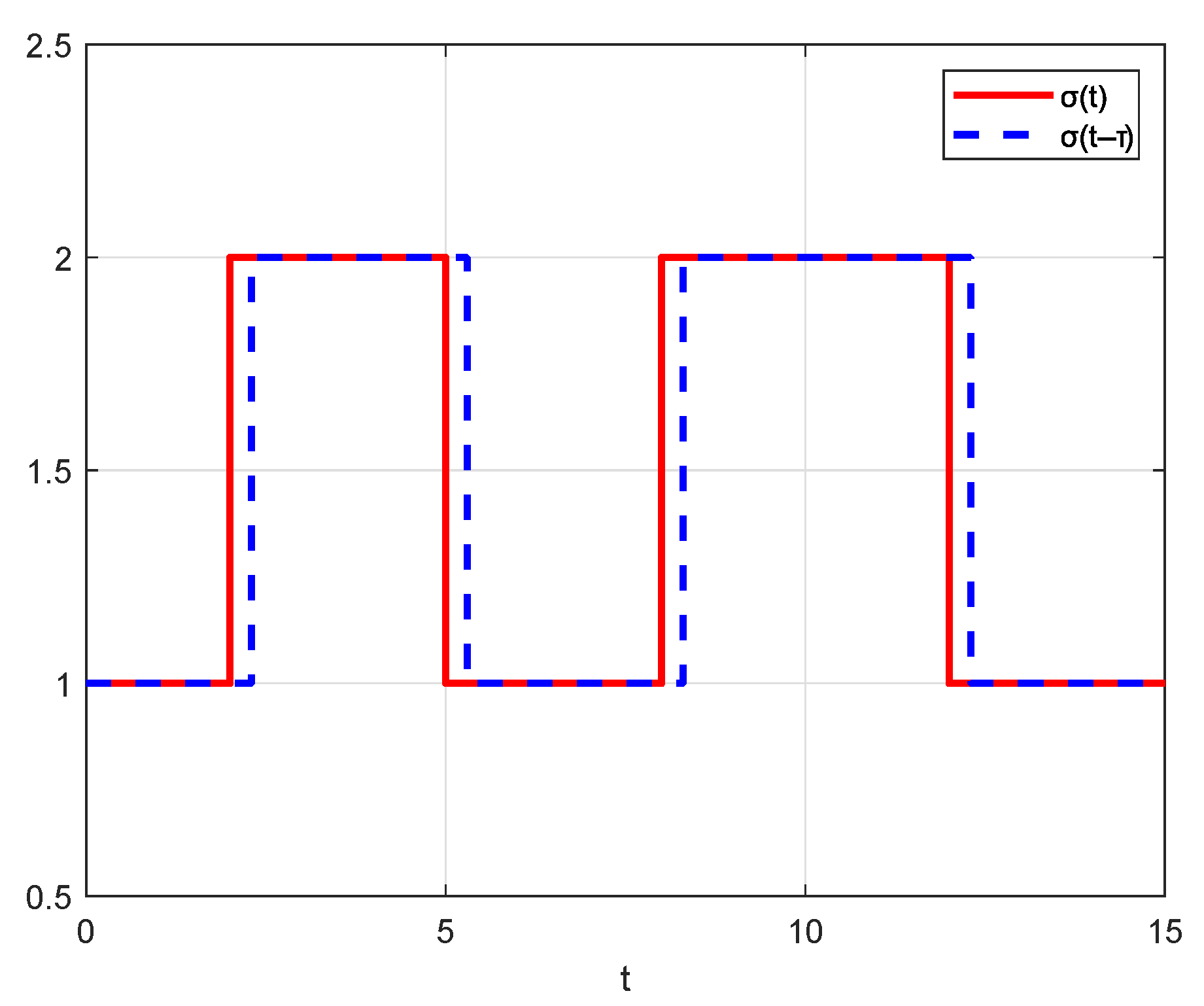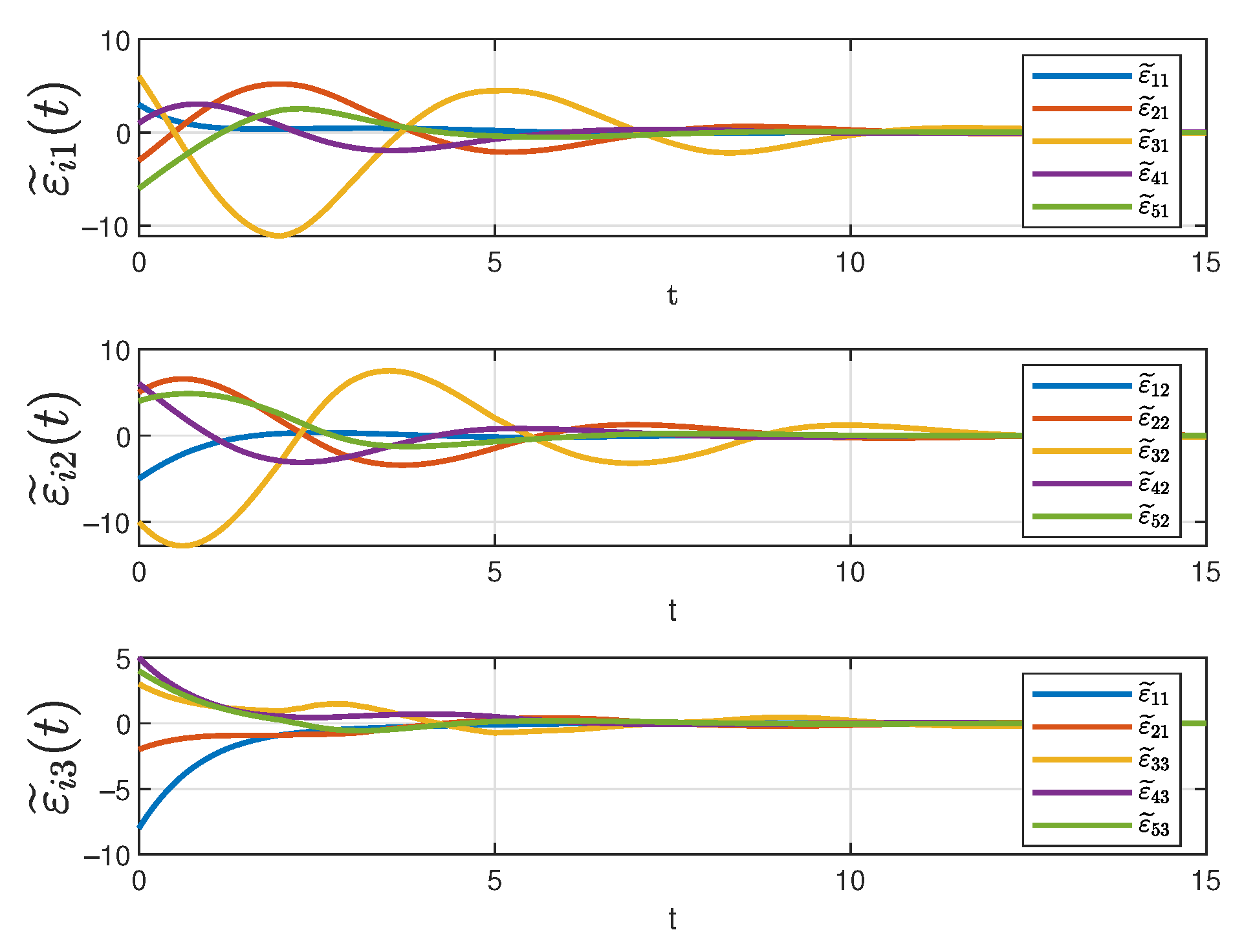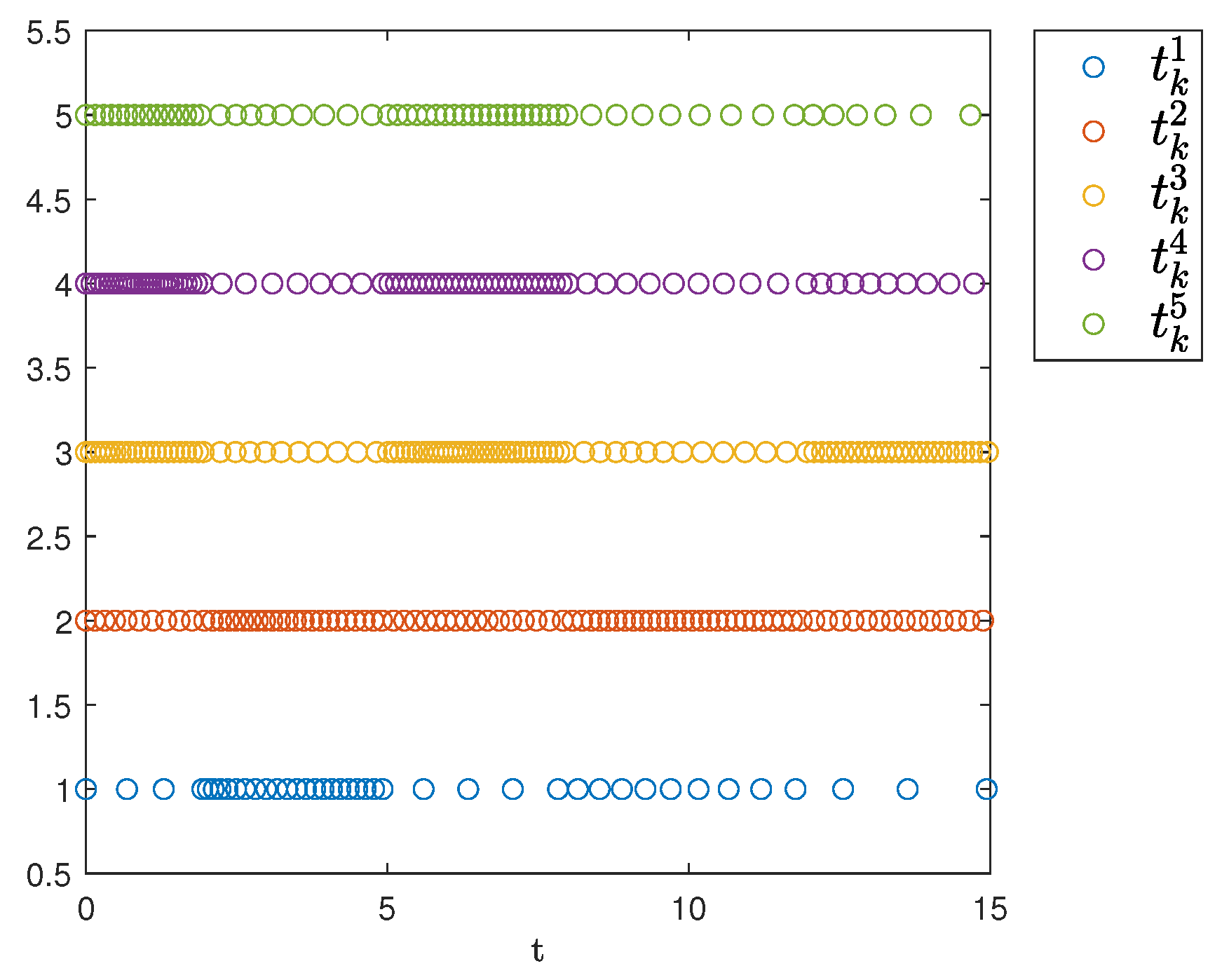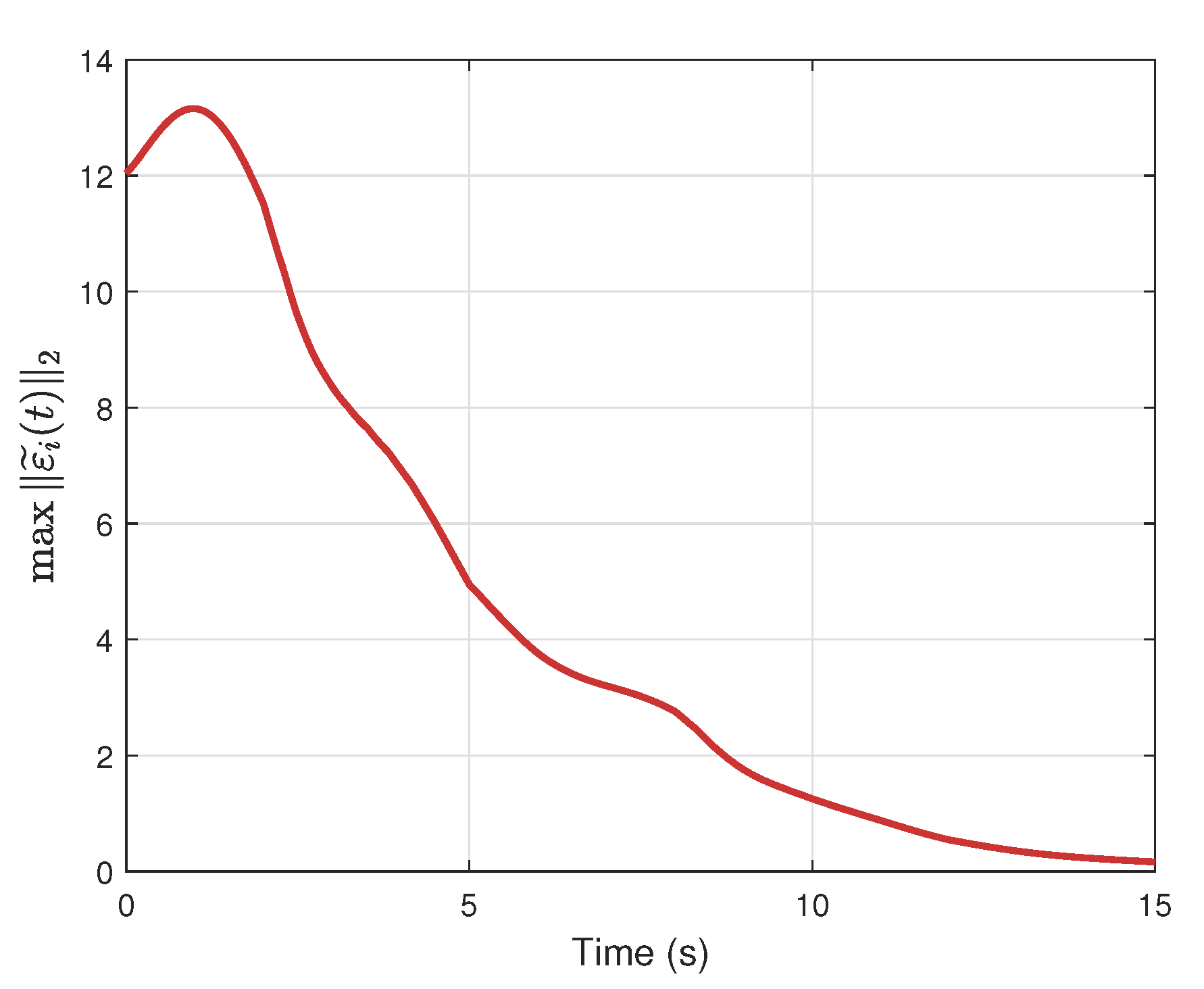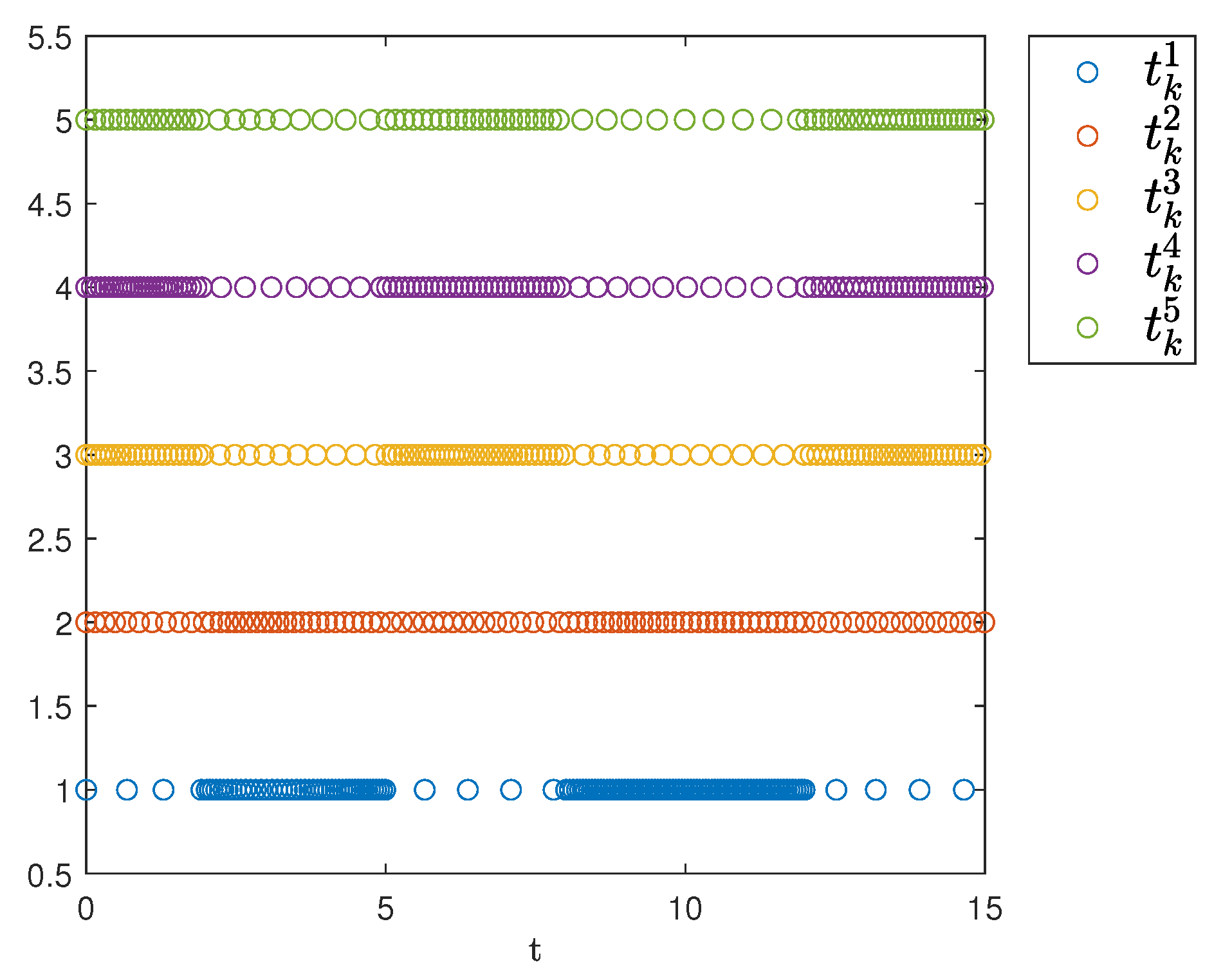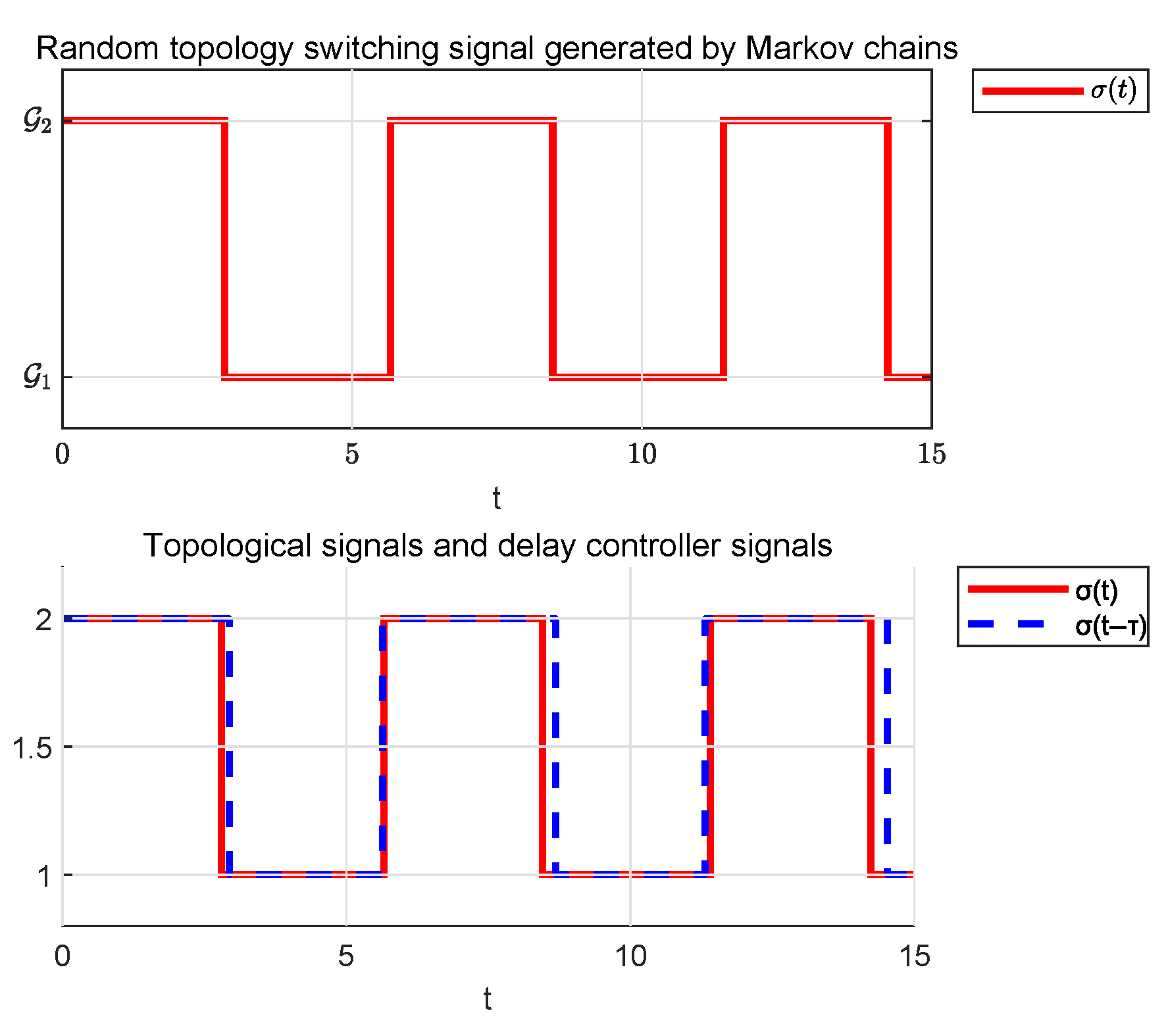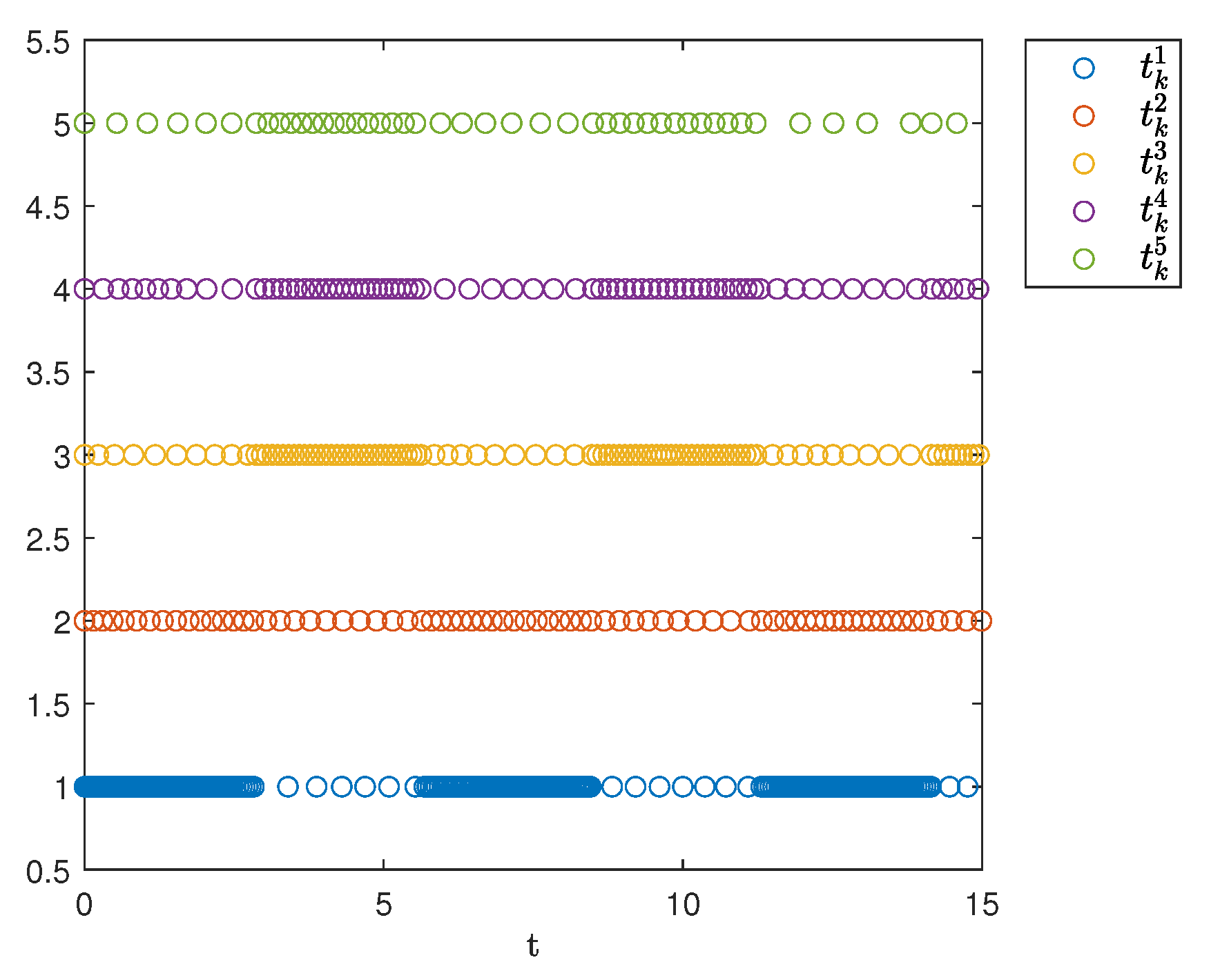To achieve tracking consensus under asynchronous switching, this section proposes a dynamic event-triggered controller based on undirected topology. Furthermore, it is rigorously proven that Zeno behavior is excluded under the proposed control scheme.
4.1. Dynamic Event-Triggered Control Protocol Under Asynchronous Switching
We define a combined measurement variable,
Let
, and then the state measurement error of the system is
, where
is the triggering time of follower
i. The tracking error is
, representing the error between the leader and follower. Based on the tracking error and (
3), we have
Define
and
, and then (
4) becomes
.
In the triggering interval
, the combined measurement variable remains constant,
. Substituting this into (
3), we obtain
. Using the relationships between state information,
, and
, we have
Meanwhile, denote , and the Kronecker form of is .
The distributed control protocol for agent
i is designed as
where
is the feedback gain.
denotes the controller switching signal, and
is a delay that varies over time. Based on
, the structure of the closed-loop controller is expressed as
.
The relationship between the variables
, and
is shown in
Figure 1.
Remark 1. The control protocol (
6)
designs specific feedback gains for each graph , which are topology-dependent. Due to transmission delays or the time required to detect topology switching, a time delay is introduced in the control protocol. This delay affects the real-time responsiveness of the control protocol and constitutes a non-negligible factor in the system design. The dynamic equation of
is calculated as
. Substituting the closed-loop controller matrix into this equation yields
where
.
According to the
, the tracking consensus defined in (2) is achieved only when
, that is,
. This implies that the tracking consensus can be reduced to the asymptotic stability analysis of the closed-loop system (
7), which ensures that
holds over the network.
The set
represents the sequence of triggering times in the ETM. For follower
i, the DETM that determines its triggering instants is
The dynamic variable
satisfies the following rule:
Additionally, the parameters satisfy . Since the DETM is applied exclusively to the followers, the tracking error is .
Remark 2. The design principle of the DETM determines the next triggering instant based on both the measurement error and measurement state . The measurement state is intrinsically connected to the weighted Laplacian matrix . This connection enables the DETM to immediately respond to communication topology changes during agent connectivity variations. Therefore, this capability ensures efficient and stable operation of MASs.
Remark 3. The distinction between the SETM and DETM lies in the incorporation of dynamic variables. When the dynamic variable , the DETM in Equation (
8)
reduces to a SETM. Importantly, compared to the SETM, the DETM allows for longer inter-event intervals due to the additional term , which greatly lowers the probability of Zeno behavior. In this paper, we design a topology-dependent controller and investigate the asynchronous switching scenario where a time delay exists between communication topology switching and controller switching. Additionally, we emphasize the influence of this switching delay on the system performance and stability. As shown in
Figure 2, the temporal evolution of the controller switching signal and the communication topology switching signal indicates the presence of a non-negligible time delay between them. This visualization provides an intuitive understanding of critical issues in asynchronous switching processes, providing a theoretical basis for the development and analysis of subsequent control strategies.
Let denote the switching instants of the signal and denote the detection delay signal between the controller and the communication topology, which specifies the time delay over the interval . If the communication topology switching instants are and , the corresponding controller switching instants become and . The entire timeline is divided into two parts. The black part represents the mismatch periods between the controller and the communication topology, such as . The yellow intervals are match periods, such as .
Remark 4. Asynchronous switching causes a control mismatch within the interval because of the delay between the topological structure switching and the controller switching. When is small enough, the delayed interval shortens and the controller switching instant comes closer to the topology switching instant . Consequently, the system behavior is roughly similar to the synchronous switching mode, where the controller and topology transitions coincide nearly instantaneously.
Lemma 2. The tracking consensus problem is addressed by the control law (6) when the following systems are asymptotically stable: Proof. For the weighted Laplacian matrix
, there exists an orthogonal matrix
for any
, satisfying
, such that the following equation holds:
Denote
, and
, and (
7) is described as
Introduce the following transformation: , , , and .
As (
13) comprises
N individual subsystems governed by (
10), the asymptotic stability of each subsystem induces asymptotic stability in the system (
7). □
Remark 5. By introducing the transformation matrix and modal coordinate transformation, the system analysis process is substantially simplified. By using the spectral decomposition of , this transformation ensures that the topological correlation characteristics in control input (
6)
are reduced to eigenvalue regulation through the diagonal matrix . This method avoids the computational complexity associated with a high-dimensional matrix. Consequently, it limits the asynchronous switching effects caused by time delays to local adjustments of the gain matrix , significantly improving analytical efficiency. Remark 6. According to Lemma 2, the analysis of confirming the asymptotic stability of the system (
10)
can be used to solve the tracking consensus for systems (
1)
and (
2)
. The design of controllers under asynchronous switching is easier by the application of Lemma 2, which reduces the complexity of the controller design. According to
Figure 2, consider the interval between successive topology switches
. Within this interval, the communication topology remains fixed as
. The controller switching signal
is affected by the delay
, and its dynamic process is divided into two parts. During the delayed period
,
remains consistent with the previous topology switching signal
. In the synchronized period
,
aligns with the current topology signal
. The mathematical description is given by
For any switching instances
, the control protocol in (
10) is equivalent to
The transformed tracking error is equivalent to
Let
, then
Remark 7. When , the topology is activated over the interval . However, due to the time delay , this interval is divided into two distinct subintervals. During , the controller remains synchronized with the topology and is thus referred to as the synchronized controller. In contrast, the controller is unable to synchronize with the current topological state within as it does not match the active topology. Throughout this subinterval, the subsystem is controlled by a delayed controller. This de-synchronization between the controller and the topology constitutes the asynchronous switching behavior exhibited by the system.
Figure 3 illustrates the control principle under asynchronous switching conditions. A distributed control protocol
and a DETM are designed for the
i-th agent. To reflect the time lag, the switching of the topology structure is governed by the function
, while the controller switching is regulated by the delayed switching signal
. The ETM determines whether the control input needs to be updated based on the agent’s current state
and specifies the next triggering instant
. Then, the controller computes the control input
using the information at this instant, achieving effective control under low-frequency triggering.
4.2. Consensus Analysis
Lemma 3. Let and be two classes of functions. Suppose there exist functions that make the inequalities (
16)–(
18)
hold. Then, system (
10)
achieves global asymptotic consensus. Furthermore, the ADT of the switching signal satisfies (
19)
, where , and . Proof of Lemma 3. Within the switching interval
, the following formula is derived based on (
17).
Combining (
18) with (
20), we obtain
Setting , then .
According to Definition 2 of the ADT, it has
, and the switching delay satisfies
. It then follows that
Since
,
converges to 0 as
. Furthermore, based on (
16), it follows that the system achieves asymptotic stability. □
Theorem 1. For each agent i, assume there exists a positive-definite matrix that satisfies the following inequality. In addition, if the parameters in the DETM (
8)
and (
9)
meet the specified inequalities and equations, then the nonlinear MASs described by (
10)
are guaranteed to be stable.where , and . Proof of Theorem 1. A model-dependent Lyapunov function for each agent
i in the system (
13) is designed:
The topology-based DETM defined in (
8) ensures that the inequality (
23) is always valid.
When the internal dynamic variable (
9) is introduced,
Therefore, , and noting that is a positive-definite quadratic form, so .
Case 1. During the asynchronous interval
, the controller does not match the communication topology. Compute
:
Apply the Lipschitz condition,
, and it is obtained that
Compute
. According to the normality of orthogonal matrices,
,
.
Compute the Lyapunov bound:
Because
, and
, we have
Let . Due to , then .
Case 2. During synchronous interval
, the controller synchronizes the communication topology. Following similar steps,
Suppose
, then
Also, , so .
Based on the proof of the synchronous and delayed intervals, it is obtained that
It follows from (3) that
converges to 0 as
. Hence,
, indicating that the nonlinear systems (
1) and (
2) achieve tracking consensus. □
Based on the above stability analysis, a method for designing stabilizing controller gains is derived. Let
and
. By applying a congruence transformation to
and
in (1) using
, we obtain the following.
Bring
into
And , . From this, we present the following control design scheme.
Remark 8. An augmented Lyapunov function that incorporates internal dynamic variables from the DETM is constructed in order to eliminate Zeno behavior. Through the regulation effect of this variable, a strictly positive lower bound for event-triggered intervals is guaranteed. To sustain continuous system stability, the function must continue to exhibit its non-increasing property at the moment of communication topology transition.
Theorem 2. For given constants , , , , and , and assuming , suppose there exists a positive-definite matrix and matrices such that the inequalities (34) and (35) are satisfied for any . Then, if the switching signal satisfies , the system is stable, and the control gain matrix is given by .
The control gain synthesis procedure is shown in Algorithm 1.
| Algorithm 1: Asynchronous switching control gain matrix based on DETM |
Input: The matrices , , related parameters of ADT and DETM Output: Controller gain matrices - 1
Step 1: Compute transformation matrices and , then obtain - 2
Step 2: Validate - 3
Step 3: Solve LMIs , then obtain matrices and - 4
Step 4: Ensure and - 5
Step 5: Compute control gain matrix
|
Remark 9. We utilize the LMI toolbox to solve the control gain matrices satisfying the conditions of (
34)
and (
35)
, which are designed for both synchronized phases and delayed phases. This method ensures stability under asynchronous switching while lowering design complexity by transforming the Lyapunov stability conditions into LMI constraints and suppressing time-delay disturbances at the same time. 4.3. Feasibility Analysis
To ensure the feasibility of the triggering mechanism, it is necessary to prove that no agent exhibits Zeno behavior. This implies that an infinite number of triggering instances cannot occur within a finite period of time. Therefore, it is necessary to discuss the existence of a positive lower bound for the time between events. In this paper, there are two different types of time sequences: one is the time subsequence induced by the DETM and the other is the time subsequence induced by the switching function.
Lemma 4. Under a fixed topology, the triggering time intervals generated by the ETM have a positive lower bound.
Proof. According to the definition of Dini derivatives, for any time instant
,
is piecewise differentiable. This property implies that
where
,
.
Further, it is known that . Then, .
According to our definition, at the trigger moment,
,
. The DETM indicates that within the interval
, the inequality
always holds.
The Equation (
24) tells us
By combining (
36) with (
37), the lower bound of the time difference between consecutive triggering instants is derived as
. Clearly,
remains strictly positive within any finite time interval. □
We first consider the time subsequence generated by the DETM.
Case 1. During the interval , the communication topology remains unchanged. According to Lemma 4, there is no Zeno behavior within this interval.
Case 2. If the topology structure undergoes n changes during the interval , let denote the triggering instants caused by topology switching, forming a switching time sequence . The time intervals are divided into three scenarios. First, consider the subinterval . Although this is an open interval, neither event triggering nor topology switching occurs within it, thereby imposing constraints on the number of triggering occurrences during this period.
In the second scenario, within the subinterval , no event triggering occurs and the topology structure undergoes only a finite number of switches. Since this does not satisfy the definition of Zeno behavior, the possibility of a Zeno phenomenon is ruled out.
For the third scenario, the communication topology remains unchanged over the interval . In this case, the system evolution is equivalent to the first scenario, allowing the same proof method to exclude Zeno behavior.
In summary, the triggering time sequence generated by the DETM is free from Zeno phenomena.
Then, consider the time subsequence generated by the ADT. According to Definition 1, the number of topology switches is finite within any finite time interval. Therefore, Zeno phenomena cannot occur because the time subsequence caused by topology switching does not possess the attribute of infinite accumulation.
Furthermore, existing studies have established that if multiple time sequences individually do not exhibit Zeno behavior, their combination will also not induce Zeno phenomena [
29]. Based on the preceding analysis, the time sequences generated by the DETM and the switching functions have been proven to be free from Zeno behavior. Consequently, we can assert that the entire system avoids Zeno phenomena, meaning no agent will experience infinite triggering within any finite time interval. This completes the proof.

